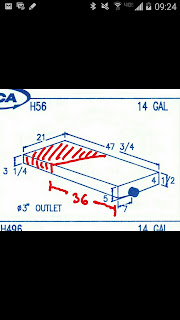The Avion doesn't have a grey water tank. We've read that prior to 1972 or 1973, campers just didn't have grey water tanks.
With our current camper, the 1965 Security Traveler, we use an external 5 gallon carboy, connected to the sink drain with a small hose. It works fine but it isn't ideal. Why? Because of grizzly bears. Montana has a lot of grizzly bears.
And if it isn't the grizzly bears, it's the black bears. Responsible camping means keeping your food waste, including grey water, out of reach of bears. So every night, we put the carboy in the back of the truck.
Another problem is that the carboy full of grey water can freeze. And another is that it doesn't look fantastic, but that is the least of the concerns really.
For all those reasons, we want the Avion to have an enclosed grey water tank, away from bears and fairly protected from freezing.
The Avion does have a black water tank, but since it sits mostly above the floor height, it won't work as a grey water tank. Once the water level filled up the few gallons BELOW floor height, it would start to back up into the shower. (Below: The toilet sits on top of the black water tank; toilet is removed for now but you can see several inches of the black water tank standing above the floor).
I advocated for taking out the toilet and black water tank completely, but for various reasons, that would not buy us any extra space, so those are staying. (Well David took them out after this photo was taken, but they will eventually return).
Challenge: We needed to find a tank that fits the space between the camper floor joists and is also 4 and 3/4" deep (that is the distance between the floor and the belly pan).
Based on other people's blogs and FB discussions, we checked out Inca Plastics on line. They are really helpful. You can download a catalog of all their various RV tanks from their website.
David measured, looked at options and then had some email with the company (they are very helpful). We want a tank that sits here, in the upper right bay of floor joists:
In this photo you can see (clockwise) the waste pipe from the kitchen sink, the shower drain, the bathroom sink drain, an empty bay, and the hole where the black water tank used to be. This is looking at the back of the camper.
Our choices for a water tank are either a 7 gallon tank (one of many standard sizes, fits in that bay), or 12 gallon tank (must be made by modifying a standard 14 gallon tank, would require cutting into one of the floor joists). Since David knows how to weld, we think it will be ok to do the bigger tank (cut out part of the joist and then re-enforce it after the tank goes in). That joist needs some work anyway.
Another part of the challenge is to line up the waste outlets for the grey and black water. We want the outside of the camper to remain as original as possible, so we don't want to add any new holes. The original design and fabrication look pretty nice.
We will let you know how it goes.










































